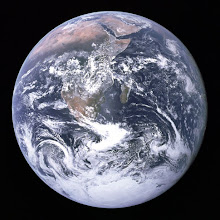I believe that this could a "partial" solution to the piece immediately below this one, on teaching and training new generations of students for uncertain times. When we understand systems, we can discern patterns (or potential patterns). When we can discern patterns, we are better equipped to manage uncertainty.
There is a lot of rich educational material on the NASA web site, which I believe will have increasing relevance for this site. This following is but one example. I will elaborate upon this theme in upcoming posts.
Blaine
***
In April 2001, a typhoon churned up a dust storm in China that sent dust as far as the Great Lakes and Maryland. Image Credit: NASA
Learn to Teach Earth as a System
A dust storm from China brings an increased risk for asthma sufferers in the western United States. Melting polar ice threatens sea levels high enough to submerge an island nation along the equator. And a cyclical decrease in solar energy can temporarily offset the warming influence of greenhouse gases.
These are just a few examples of how what happens in one part of the world or solar system can affect places and people far away and how interwoven Earth's various components really are. Understanding the connections among the planet's spheres -- biosphere, atmosphere, cryosphere, hydrosphere and lithosphere -- is crucial to preparing today's students to meet the challenges of our complex and constantly changing environment.
The Earth System Science Education Alliance -- sponsored by the National Science Foundation and NASA and administered by the Institute for Global Environmental Strategies -- supports a network of more than 40 educational institutions across the country in offering a series of semester-long, online Earth system science courses for K-12 and informal educators. More than 3,000 teachers have completed an ESSEA course since the program's inception in 2000.
ESSEA participants earn undergraduate or graduate credit while learning to teach Earth system science using inquiry-based classroom methods. Learning modules used in the courses are available to anyone through the ESSEA website. Each module starts with a scenario (text and images) that sets the stage for investigation of an Earth science topic. Many of the modules incorporate problem-based learning.
New modules are added regularly with examples including:
- Dust World: Dust may be one of the least understood aspects of Earth's atmosphere. Yet a dust storm on one side of the globe can travel to and affect areas on the opposite side. The impacts on weather, climate and health can range from a decrease in hurricanes to increased reports of asthma.
- Sea Level Change/Coastal Inundation: More than half of the U.S. population lives within 50 miles of the coast. Climate change is expected to produce differing amounts of sea level rise in different locations around the world, with hard-to-predict consequences for coastal communities and economies.
- Sunspots: Sunspot activity waxes and wanes with a maximum occurring, on average, every 11 years. When sunspot numbers are low, the amount of solar energy reaching Earth is reduced, which could result in a temporary cooling effect.
"Studying Earth and global climate change is similar to putting together a jigsaw puzzle. The more we look at the planet in terms of interactions among its different components, the better we understand how all the pieces fit together," said Bob Myers, principal investigator for ESSEA. "The ESSEA courses and modules allow teachers and their students to take a critical look at potential threats to Earth's health from a systems perspective, and to grow in the critical thinking skills needed to become environmentally literate citizens." [Emphasis added]
Course offerings, modules and additional information are available at http://essea.strategies.org →










No comments:
Post a Comment